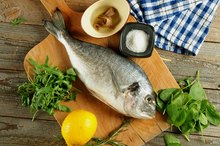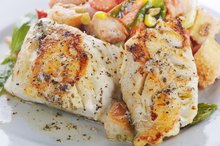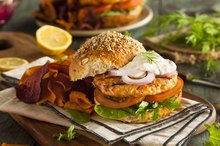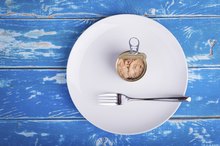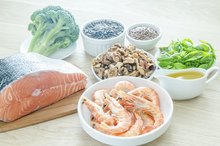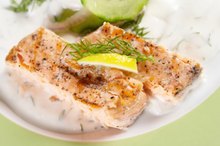Is Whiting Fish High in Omega 3?
You may have heard that eating fish twice a week is heart-healthy, as well as a potential treatment for problems ranging from arthritis to learning disabilities. That’s because some fish are high in the anti-inflammatory agents known as omega-3 fatty acids. Omega-3s are linked to lowering cholesterol and blood pressure and boosting immunity. But, not all fish contain high amounts of the fatty acids. Lean fish varieties such as whiting may provide several nutritional benefits, but a high amount of omega-3s is not one of them.
About Whiting
Not to be confused with whitefish, which is rich in omega-3s, whiting is an economical fish of the Pacific. Some people know whiting as Pacific hake. The non-oily white fish work well in deep-fried dishes, and as baked or pan-fried entrees. According to the California Seafood Council, fish processors use minced whitefish to make “imitation” crab, shrimp and scallop foods 1.
- Not to be confused with whitefish, which is rich in omega-3s, whiting is an economical fish of the Pacific.
Omega-3s and Whiting
Fish Containing Highest Levels of EPA & DHA
Learn More
In general, fatty fish make better sources for beneficial compounds such as omega-3 fatty acids than lean fish do. A serving of whiting contains only 1.69 g fat, compared to the 13 to 18 g fat found in salmon and mackerel. (See References 3) Other non-oily fish low in omega-3s include:
- pike
- flounder
- haddock
- snapper
- sole
- cod
- halibut
- grouper
Better Omega-3 Choices
According to the University of Minnesota’s Sea Grant program, the best fish for omega-3 fatty acids are those with a high concentration of oils 2. An analysis conducted by Purdue University found that dogfish, two kinds of lake trout and several mackerel and salmon varieties all contributed at least 2 g of the nutrient per serving. Of the plant-based foods, walnuts and soybeans were the highest in omega-3 fatty acids.
Whiting Benefits
Nutrition of Mahi Mahi Vs. White Fish
Learn More
While whiting aren’t a good choice for the two servings of omega-3s suggested by doctors, it does provide other benefits. Whiting’s low overall fat content means that the fish isn’t high in unhealthy saturated fat. If you are watching your calories, whiting may make a more desirable choice than oily fish. Providing 24 g protein, whiting has 116 calories, compared to salmon and mackerel, which have about the same amount of protein but are at least 100 calories higher. With 6 percent of your DV for calcium, whiting is also higher in the crucial mineral than salmon or mackerel.
- While whiting aren’t a good choice for the two servings of omega-3s suggested by doctors, it does provide other benefits.
- With 6 percent of your DV for calcium, whiting is also higher in the crucial mineral than salmon or mackerel.
Related Articles
References
- The Nibble: Fish and Seafood Glossary
- American Heart Association. Getting Healthy. Fish and Omega-3 Fatty Acids. Updated March 23, 2017.
- U.S. Department of Agriculture. FoodData Central.
- National Institutes of Health. National Center for Complementary and Integrative Health. 7 things to know about omega-3 fatty acids. Updated October 9, 2019.
- Rizos EC, Ntzani EE, et al. Association Between Omega-3 Fatty Acid Supplementation and Risk of Major Cardiovascular Disease Events A Systematic Review and Meta-analysis. JAMA. 2012;308(10):1024-1033. doi:10.1001/2012.jama.11374
- Natural Resources Defense Council. Nicole Greenfield. The smart seafood buying guide: five ways to ensure the fish you eat is healthy for you and for the environment. Updated August 26, 2015.
Writer Bio
Ellen Douglas has written on food, gardening, education and the arts since 1992. Douglas has worked as a staff reporter for the Lakeville Journal newspaper group. Previously, she served as a communication specialist in the nonprofit field. She received her Bachelor of Arts from the University of Connecticut.

